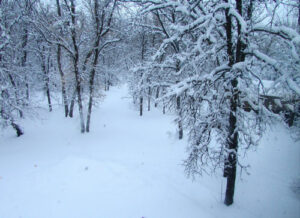Villard (Main St.) and Walnut (2nd Ave. SE)
The 2020 photograph of this location shows the currently unoccupied site, until recently the home of a local car dealership. The Leader Block, a Heritage Certificate Site, remains visible in the background.
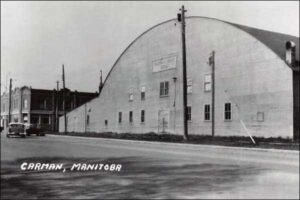
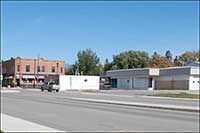
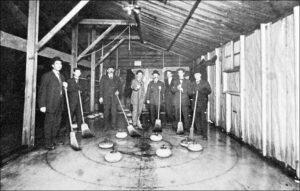
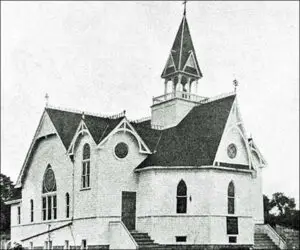

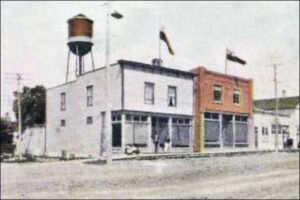
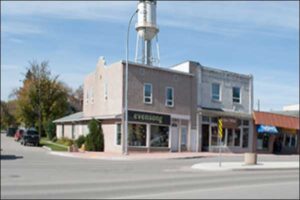
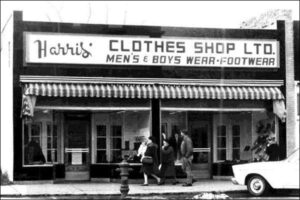
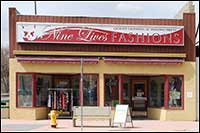
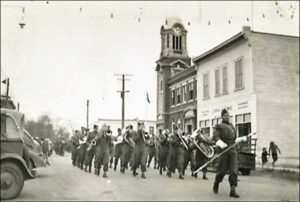
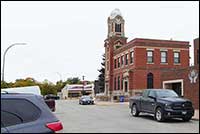
Villard (Main St.) and Walnut (2nd Ave. SE)
Anyone passing the corner of Villard (Main St.) and Walnut (2nd Ave. SE) between 1928 and 1958 would have viewed this massive rink on the east side of the street. Rinks have long been a central feature of winter sports in Carman. The first Carman rink was built in 1898 on Fournier St. (1st. St SW) near present location of Toews Printing (The History of the R.M. of Dufferin in Manitoba 1880-1980, p.278). The second rink, shown in this photo, was the local focal point for hockey, skating and curling from 1928 to 1958 when the roof crumbled under the weight of snow.
77 2nd Ave
Some buildings change more in function than in appearance. This impressive building located at 77 2nd Ave. SW in Carman is now the Bell Aura Bed and Breakfast/Bistro. To see the original building, built as a church in 1898-99.
St. Andrew’s Presbyterian Church was designed by architect Edmund Watson and built by local contractor, R. McKinney and mason George McCormick. Services were held here until 1941, when the congregation joined what is now the Carman United Church. The building was sold in 1945 to the Church of Christ. In recent years it has housed the popular Walnut Street Tea Room and is now home to the Bell Aura B&B/Bistro. The steeple was removed and, along with the bell from an earlier Presbyterian Church, is preserved on the grounds. Based on its architectural features and historical significance, the building has been designated a Heritage Certificate Site. For further details see The History of the R.M. of Dufferin in Manitoba 1880–1980, pp. 202-4; Carman Dufferin Leader, 1989-09-22.
Main St. & 2nd Ave., Carman
For many years, the building on the NW corner of Villard St. and Walnut Ave. (Main & 2nd) housed a grocery store. Around 1909, A. E. Hill sold the store to R.D. McKee, the owner when this photo was taken in 1912. Other occupants over the years include the Carmania (groceries and restaurant), Red and White Store (groceries) and Carman Radio & TV. It is now Evensong gift shop. Apartments occupy the upper floor and back of the building.
Until recently, the second building housed furniture stores (Doyle’s, 1905–61; Bruce’s, 1961–71; Carman Furniture, 1971–98). Doyle’s Funeral Home was located here as well from 1905 to 1945 when it moved to the present location. Aspen Winds now operates a craft outlet at this site.
In the early 1900s, J.H. Haverson’s law office occupied the small building next door. Wm. Smith operated a barber shop here from 1928–52 when the building was demolished. Knockabouts clothing store is now at this site.
Corner 1st Street and 1st Avenue SW
From 1896 until 1946, a two-story building occupied this site at what was then known as the corner of Fournier St. and Maple Ave. The Victoria Hall, on the second floor, was a busy venue for meetings and other events such as theatre productions. The main floor housed clothing stores. Among the early owners were Frank Harris (1898) and Richard Hart (1906). In 1924, F.C. Harris took over his uncle’s men’s wear business—at that time located on Maple St.—and moved it back to this site. When the building was destroyed by fire in 1946, F.C. Harris rebuilt the store and started carrying a line of shoes as well as men’s clothing. This is one of several Carman sites C/D MHAC has recognized through our Business Sign project.
1st Ave. SW (formerly Maple Ave.)
Past, Present, Future. Can knowledge of the Past help us plan for the future? That’s the question that has been in our thoughts since we were invited to meet with other local organizations to share insights and perspectives on the future of the community. What mightlocal heritage contribute to the discussion?
The visitor who in the lovely Manitoba summer days, stops at the town of Carman, romantically . . . abound on every hand of our fair town
Heritage is often seen by communities in terms of tourism – museums, heritage sites, the house where so-and-so was born, or statues that are in some way symbolic of the area – think pumpkins, turtles, or in Carman/Dufferin area, the namesake Roseisle Rose.
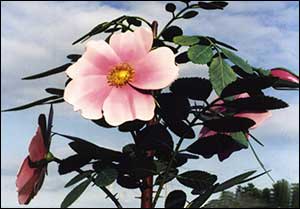
Perhaps, through hindsight, knowledge of local heritage also can identify strengths and limitations of the community and in that way help define our future.
Early Visions.
Back in 1907, shortly after the Carman incorporated as a Town, a local newspaper reporter asked “What does Carman want?” (Carman Dufferin Leader, 1907-01-03). They then provided their own view of what the town needed. This included development of local industries to provide essential goods such as wire, bricks, shoes, and white-wear, along with employment for everyone at good wages. To achieve this would require a united and aggressive effort by everyone in the community and action, not just words, on the part of local leaders.
Over a century later, those goals still sound rather familiar. Although the list of essential industries has no doubt changed, the goals remain relatively the same. Given the recent call for input from the community, it even seems possible that a fresh, new breeze of collaboration might be wafting through the community.
Notice that the 1907 article focussed on community needs or deficits. Other newspaper reports from that era reminded readers that the community also had special assets on which to build a vibrant future.
The Natural Environment – Then & Now.
An earlier Carman Dufferin Leader (1898-05-12) waxed eloquent about the community’s natural setting:
The visitor who in the lovely Manitoba summer days, stops at the town of Carman, romantically nestling in the encircling windings of the River Boyne and sheltered by its bordering fringe of stately virgin oaks, is heard to remark “Why, what a lovely spot.” For beauty of situation Carman is not excelled by any other town in the province. Sheltered and embowered by a magnificent belt of oak, ash, maple, elm, bass wood and poplar, it is hard for a visitor who hails from a timbered country to realize that this is indeed a prairie town….It should be said for the originators of the town that their appreciation of the beautiful has preserved to us as far as possible the original trees, which gives to many of our streets the appearance of broad avenues, picturesquely lined with tall and stately trees. Here and there the visitor catches glimpses of beautiful vistas of river and woodland scenery, a worthy inspiration to either artist or writer. This feature has gained for our town a reputation of almost provincial note and it is becoming more widely known as a favorite resort for excursions and picnics.
Being situated only 57 miles by rail from Winnipeg, each summer finds a great number of Winnipeg citizens leaving their business and cares behind for a day’s outing to breathe the fresh pure air, enjoy the bright cheering sunshine, or promenade beneath the arched and embowered walks that abound on every hand of our fair town.
A couple of decades later the paper reported that “Miss Margaret Johnston, garden page and horticulture editor of the Manitoba Free Press…regards Carman as the most beautifully treed town she has seen in the province.” (Carman Dufferin Leader, 1926-06-10).
What is missing in these accounts is the reason these magnificent stands of trees formed an oasis in the midst of the open prairie grasslands, i.e., the existence of the river that threaded its way across the Carman/Dufferin area from the escarpment in the west to the Great Swamp in the east. It was aptly named the Rivière aux Îlets -de-Bois (“islands of wood”), later known as the Boyne River.
Our history of the river stresses its significance as the main source of water and, as such, as the lifeblood of the region. Over the centuries, Indigenous hunter-gatherers, Métis buffalo hunters and early settlers all relied on the river and its surroundings for water, shelter, fuel, and food. The Town of Carman grew up at this specific location largely because of the nearby water-driven Clendenning mill that ground grain and sawed lumber to build homes and businesses.
During the post-settlement years, the river also became known as a source for recreation. For many years, Carman’s Old Swimming Hole was the gathering spot for the community. In winter, swimming and boating gave way to skating.
Over the years, newspapers frequently pointed out the impact of a growing population on the water supply – pollution from using the river as a dumping ground for sewage, farm manure and garbage, as well as ongoing concerns about flooding and the need for dams and bridges. During these years, the community also began to show an interest and pride in beautifying gardens and home properties. Mayors such as S.J. Staples were noted for their efforts towards encouraging this trend by offering garden prizes, a practice that persists today.
In recent years, the community has rediscovered and begun to build upon these environmental assets. Groups such as the Boyne River Keepers (BRK) are leading the way in promoting the recreational potential of the river along with concern for water quality. They also have fostered a growing interest in the natural vegetation and wildlife along what has become the remaining wildlife corridor across the Carman/Dufferin municipalities. in recent years, the local Communities in Bloom (CIB) group has put the community even more firmly on the map with their colourful floral displays and pocket parks.
Thanks to the Stephenfield Park dam and water plant, the river now provides water for both the Town and R.M. and serves as a well-used recreation centre. As farms expanded and ponds and sloughs were drained, the river also has become a source of irrigation for agriculture and refuge for wildlife.
These observations carry significance in that they are being recorded on April 22, this year’s Earth Day.
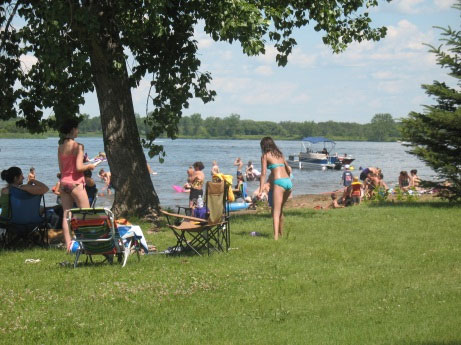
Stephenfield Park
The Economy – Then & Now.
Much of the impetus for local planning comes from a desire or need to develop the economy. Local histories record how the post-1870 arrival of homesteaders in the area resulted in a rapid socio-economic and cultural transition from centuries of hunting/gathering/ trade and buffalo harvesting to a land-owning, agricultural society. The Carman Dufferin Leader, (1898-05-12) pointed out that
This district is being rapidly filled up by a well-to-do and pushing class of farmers. With such backing as this a stability is assured to the mercantile and trades interests of which none in the province can boast of better.
Arrival of the railway and construction of local elevators meant that “As a market there are few places in Manitoba so favorably situated.” (Carman Dufferin Leader, 1898-05-12). This comment underlines the importance of transportation to the growth and survival of the local economy.
Until 1889, a spur line came as far as Barnsley (“End-of-Line”) north of the Carman settlement. The plan was to extend the line east of the Carman settlement to connect at Roland with a line from the U.S.A., hence going westward along what is now Highway 23. Thanks to the influence of local land-owner and politician R.P. Roblin and colleagues, the line veered westward near Carman, ensuring the future of the community and opening the way for other Dufferin settlements at Graysville, Stephenfield and Roseisle.
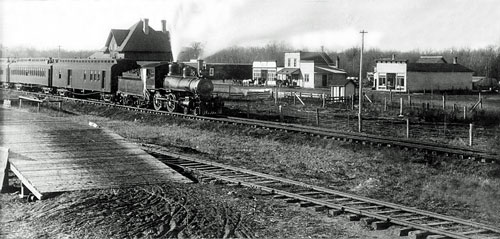
Train at Roseisle early 1900s Photo: J.B. Coleman
The significance of this coup can be appreciated by contrasting the outcome with Nelsonville, in South Dufferin. That rapidly growing community was certain it would soon become the Winnipeg or Brandon of the south – as soon as the railway arrived. When the line was routed instead through Morden, the bustling town of Nelsonville vanished from the map. Other local communities such as Bates met a similar fate.
Today, the Town of Carman stands at the junction of newly resurfaced highways that connect human and other resources from all quadrants of the R.M. to the Town of Carman as well as providing access to Winnipeg and other areas of South-Central Manitoba. This places it favourably to become a centre for whatever economic future it decides to pursue.
Health Care – Then & Now.
Given the pandemic and current health care crisis, this is one area of community planning that will no doubt be identified as a priority. Carman has long been an important centre for health care with its hospital, doctors, a fine training school for nurses.See more.
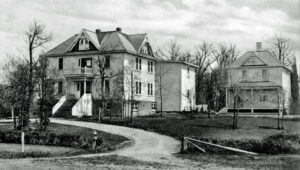
First Carman Hospital and Nurses’ Residence opened 1905 Photo: DHM
Health care has taken on even greater significance as the town has become a major retirement community. This has increased the need for chronic and long-term care as well as other age-appropriate recreational and social activities designed to maintain the physical and mental health of our senior population. Availability of health care also is a key consideration in attracting young families and workers to the area.
Sports and Recreation -Then & Now.
Both recreational activities and competitive sports are key components of a healthy lifestyle. Sports have always been a strong point of the community, for both men and women of all ages See more.
The competitive side of activities has been well-balanced by a wide range of recreational activities, from the earlier days of the Old Swimming Hole and skating on the river to recent years, when leisure activities have included walking the well-used pathway around the community. Both sports and recreation are key to maintaining a physically, mentally, and socially active population, and a healthy and keen pool of volunteers.
Hopefully, the community will plan towards a future built around support for a healthy, active, lifestyle for all age groups.
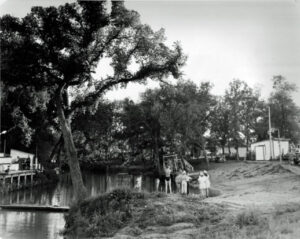
Old Swimming Hole Photo: DHM
Business Centre – Then & Now.
So far, we’ve been looking mainly at the natural strengths of the community, and their role in providing a foundation for an even brighter future. What are some of the limitations? To go back to the earliest views of the Town, (Carman Dufferin Leader, 1898-05-12) you’ll find that the actual town and business centre drew less enthusiastic applause than the natural setting:
The town itself takes a longer acquaintance before the stranger fully realizes the extent of its importance. It may be a matter of some regret that those who had the modeling of the town in its infancy did not look more to building up the business portion of it in a more consolidated manner perhaps because it just grew without recognition it would become a thriving centre.
A decade or so later, there were exceptions to that lukewarm portrait when the striking new post-office (now the Boyne Regional Library) and the then community-centered Memorial Hall were bult. One visitor even compared the Memorial Hall to the glorious Alamo in Texas (Carman Dufferin Leader, 1931-03-19).
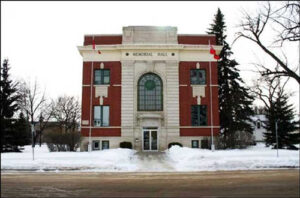
Memorial Hall
What is the business centre image today? Most local businesses excel when it comes to customer service. The buildings themselves may be another matter. Looking at the Town with an outsider’s eye at this time of year, the business section probably appears a bit tired-looking, drab, in need of a good power-wash and a touch of paint. Other than the library, Memorial Hall and older residential heritage homes, the main streets have limited ‘wow’ value.
The recent development of Ryall Park as the new gathering spot for community activities makes this corner an exception to the tired look. In a couple of months any drabness will be offset by the CIB’s colourful summer plantings and growing number of pocket parks. But there is still room for more flower boxes, planters, a few touches of paint, as well as a few surfaces that might benefit from tasteful murals.
What can Heritage Contribute? What can C/D MHAC contribute to the Plan – other than awareness of local history – our strengths, what has worked in past, and possibly past mistakes.
In the interests of promoting both healthy activity and knowledge of our roots, we can continue to add historical signage and distribution of our heritage walking tours of the Town.
Collaboration is a concept that is dear to the heart of the C/D MHAC. Since its formation, the committee has worked closely with the local museum and library on preservation and promotion of local heritage. Over the past few years, we also have nurtured ties with local groups such as the BRK, shared ‘heritage moments’ with them and applauded their rediscovery of the local lifeline and recreation potential of the river and its environs. We’ve also worked with the CIB towards projects that would honour both our heritage and natural history and serve as a local tourist attraction.
The Future?
History can provide some insight into our strengths and what worked or failed in the past, but it can’t foretell the future. What is clear is that Mother Nature is sounding ever more persistent and vocal warnings about climate change. Locally, erratic weather patterns and recent drought have heightened awareness that climate change isn’t something that is just affecting other parts the world. With that in mind, the community might do well to look carefully at its reason for existing – the natural environment – and favour development of industries that ensure water security and protect our environmental legacy.
We could, for example, become a hub for solar, geothermal and other earth-friendly industries. Cheap, clean energy in turn could pave the way for other innovative approaches such as year-round greenhouse ‘farming’. The community might well become the ‘green’, clean-energy capital of South-Central Manitoba. Hopefully these initiatives would place emphasis on jobs and training and help keep younger generations in in the community. Time and local initiative will tell.
Personally, I look forward to the day when Mother Nature can relax and smile on us again rather than bombarding us with her ever more vocal wake-up calls on climate change. It’s just so unmotherly. And I’m looking forward to the day when I can visit heritage sites in my self-driven, solar-powered flying car.
Meanwhile, back in real time, it will be fascinating to hear input and perspectives from other sectors of the community such as agriculture, health, recreation, or the Chamber of Commerce. Hopefully, we have moved well beyond 1907 and will focus on action not just words.
Natural History.
Spring seems to be just a bit late arriving this year:
